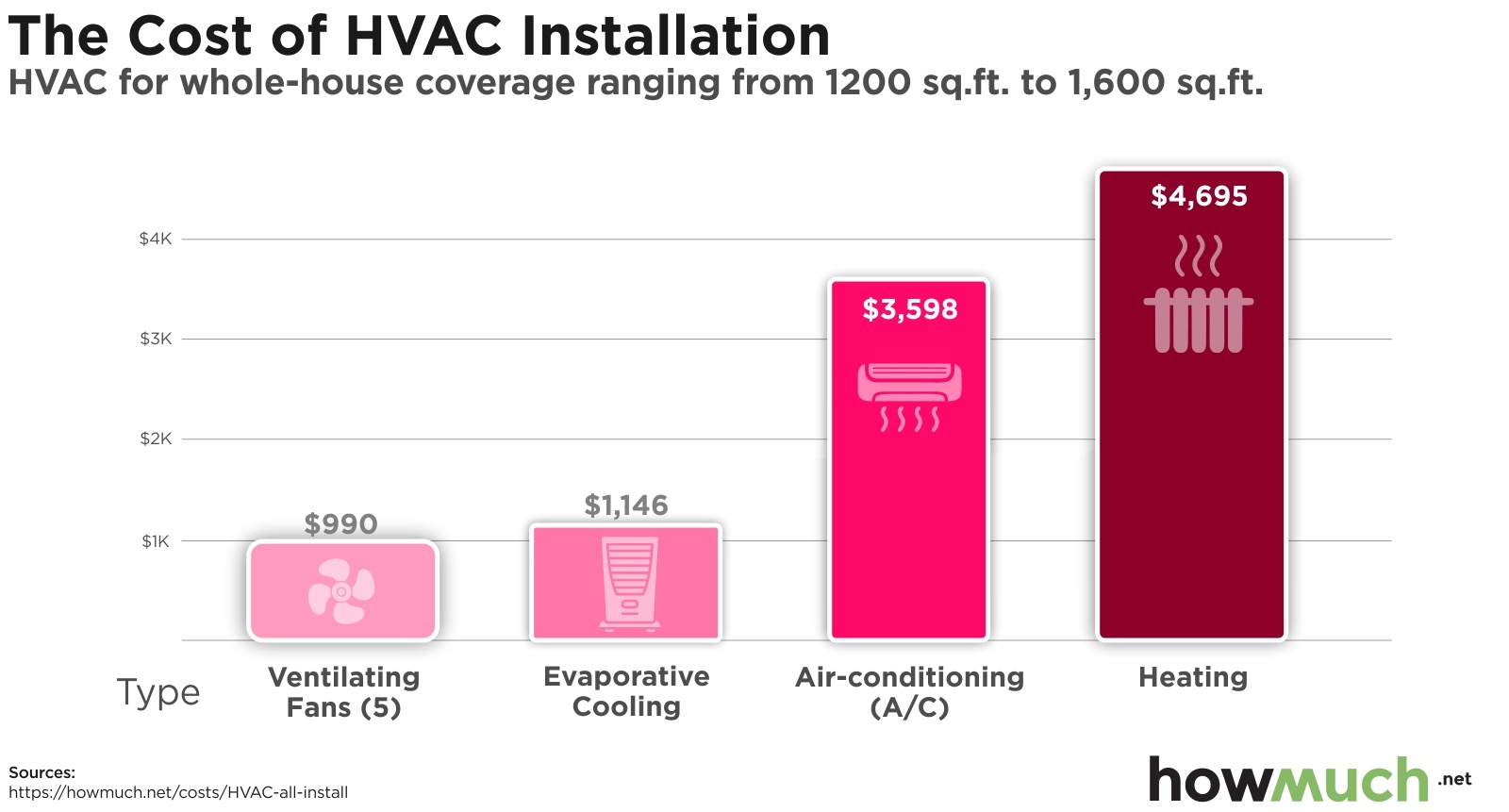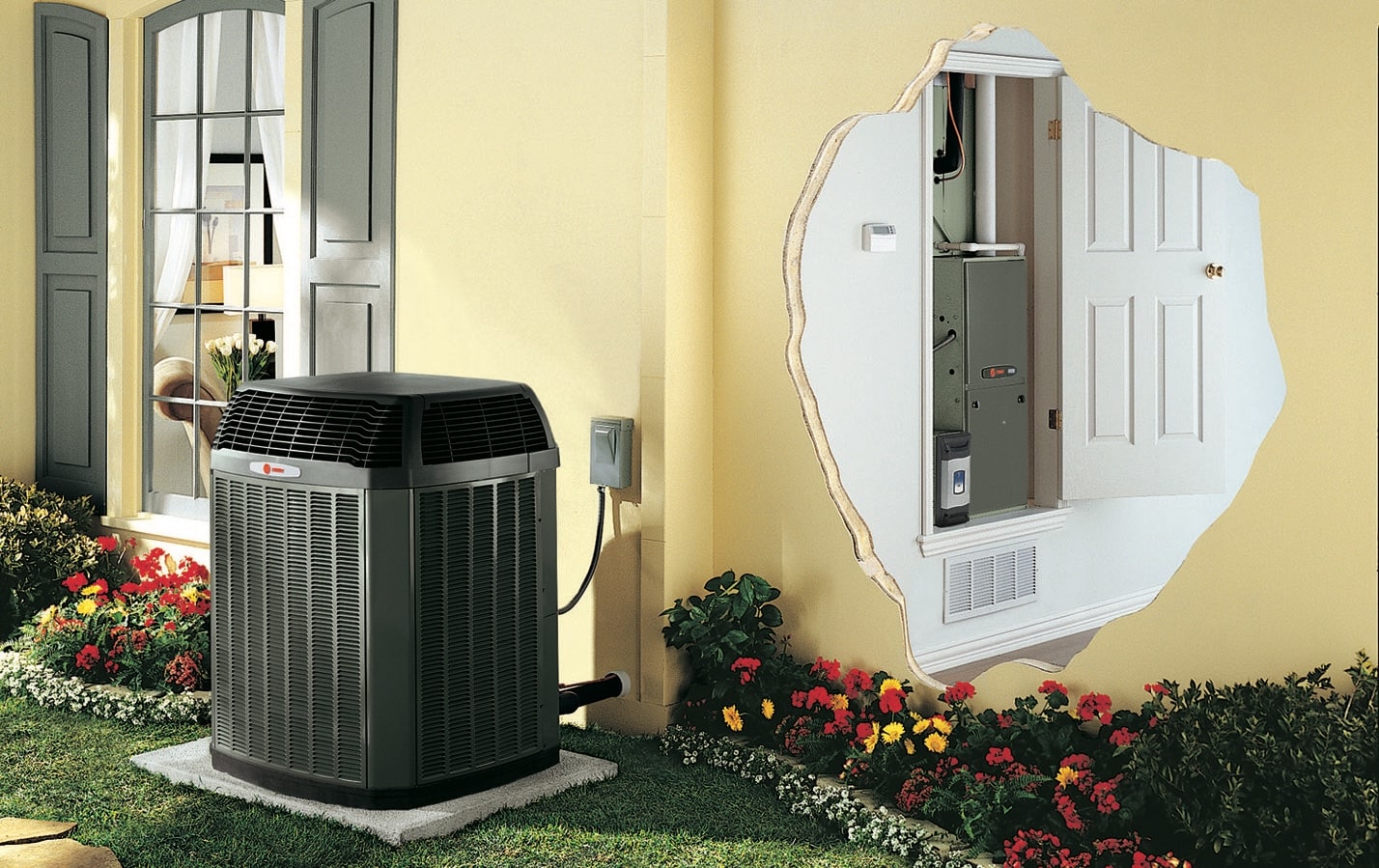How Much Is It To Install Ac And Heating

One of the most significant home improvement investments homeowners face is replacing or installing a new HVAC (Heating, Ventilation, and Air Conditioning) system. The nagging question that inevitably arises is: "How much is it to install AC and heating?" Unfortunately, there's no one-size-fits-all answer. Several factors influence the final cost, and trying to navigate them can feel overwhelming. This article aims to break down the process, providing you with a clear understanding of the costs involved and empowering you to make informed decisions.
Understanding the Cost Factors
The price of installing a new AC and heating system can vary wildly based on several key factors. Let's explore each of these in detail:
1. System Type
The type of system you choose is the single biggest driver of cost. Here's a breakdown of common options and their typical price ranges (excluding installation):
- Split Systems: These are the most common type, with a separate outdoor condenser unit and indoor air handler/furnace. Expect to pay between $4,000 and $12,000, depending on the size and efficiency.
- Heat Pumps: These systems both heat and cool your home by transferring heat. They are generally more energy-efficient than traditional systems, especially in moderate climates. Prices range from $4,500 to $15,000.
- Ductless Mini-Splits: Ideal for homes without ductwork or for individual room cooling/heating. These systems are more expensive per BTU than central systems, typically costing $3,000 to $8,000 per zone (indoor unit), plus the outdoor unit.
- Package Units: These units combine the condenser and air handler in a single outdoor unit. They are typically used for homes with limited indoor space or for commercial applications. Costs can range from $5,000 to $10,000.
- Geothermal Systems: These are the most energy-efficient but also the most expensive. They use the earth's constant temperature to heat and cool your home. Installation can cost $20,000 to $45,000 or more.
2. System Size (BTUs)
The size of your AC and heating system is measured in BTUs (British Thermal Units). A larger home requires a system with a higher BTU rating. Choosing the right size is crucial; an undersized system will struggle to keep your home comfortable, while an oversized system will cycle on and off frequently, leading to wasted energy and premature wear and tear. A professional HVAC contractor will perform a load calculation to determine the appropriate BTU rating for your home. Don't try to guess!
3. Energy Efficiency (SEER & HSPF)
SEER (Seasonal Energy Efficiency Ratio) measures the cooling efficiency of an AC unit. HSPF (Heating Seasonal Performance Factor) measures the heating efficiency of a heat pump. The higher the SEER and HSPF ratings, the more energy-efficient the system and the lower your utility bills will be. However, higher efficiency systems typically come with a higher upfront cost. Aim for a SEER rating of at least 15 and an HSPF rating of at least 8 for optimal energy savings. Many areas offer rebates for installing high-efficiency systems, which can help offset the initial cost.
4. Ductwork
If your home already has ductwork, replacing your AC and heating system will be less expensive than installing a completely new system with ductwork. Leaky or poorly designed ductwork can significantly reduce the efficiency of your HVAC system, so it's essential to have it inspected and repaired or replaced if necessary. Ductwork repairs or replacement can add several thousand dollars to the overall cost.
5. Installation Costs
Installation costs vary depending on the complexity of the job, the location of your home, and the contractor you choose. Expect to pay anywhere from $1,500 to $5,000 or more for installation. Be sure to get multiple quotes from different contractors and compare their prices and services. A reputable contractor will provide a detailed written estimate that includes all costs associated with the installation.
6. Labor Costs
Labor costs are a significant part of the installation expense. These costs are influenced by the complexity of the installation, the time it takes, and the prevailing labor rates in your area. Highly experienced and licensed technicians will generally charge more but can ensure a proper and efficient installation. It's often worth the extra cost to avoid potential problems down the line.
7. Permits and Inspections
Most municipalities require permits for HVAC installations. These permits ensure that the work is done safely and according to local building codes. The cost of permits can range from $100 to $500 or more. A reputable contractor will handle the permit process for you and schedule the necessary inspections.
8. Location
Your location significantly impacts the price. Labor costs, permit fees, and even the cost of the equipment itself can vary depending on where you live. Coastal areas, for example, may have higher costs due to stricter building codes and higher demand. Rural areas may have higher travel costs for contractors.
Getting Accurate Estimates
The best way to determine the cost of installing AC and heating is to get multiple quotes from licensed and insured HVAC contractors. Here are some tips for getting accurate estimates:
- Get at least three quotes. This will give you a good idea of the average cost in your area.
- Provide contractors with accurate information about your home. This includes the square footage, the age of your home, the type of insulation you have, and any existing ductwork.
- Ask contractors to perform a load calculation. This will ensure that the system they recommend is the right size for your home.
- Get a detailed written estimate. The estimate should include all costs associated with the installation, including equipment, labor, permits, and any other fees.
- Ask about warranties. Make sure the system comes with a manufacturer's warranty and that the contractor offers a warranty on their workmanship.
- Check the contractor's credentials. Make sure they are licensed, insured, and have a good reputation. Read online reviews and ask for references.
Simple DIY Checks Before Calling a Pro
Before you call a professional, there are a few simple things you can check yourself. These checks might save you a service call fee if the problem is something minor.
1. Check the Thermostat
Make sure your thermostat is set to the correct mode (heating or cooling) and that the temperature is set appropriately. Sounds basic, but it's often the culprit! Ensure the batteries are fresh if it's a battery-operated thermostat.
2. Check the Air Filter
A dirty air filter can restrict airflow and cause your HVAC system to overheat or freeze up. Replace your air filter every 1-3 months, or more often if you have pets or allergies. This is one of the easiest and most effective ways to maintain your system.
3. Check the Outdoor Unit (Condenser)
Make sure the outdoor unit is free of debris, such as leaves, branches, and snow. Clear away any obstructions that could be blocking airflow. Also, check the fins on the condenser for damage. Bent fins can restrict airflow. Gently straighten them with a fin comb, which you can purchase at most hardware stores.
4. Check the Circuit Breaker
If your HVAC system isn't working at all, check the circuit breaker to make sure it hasn't tripped. Reset the breaker by turning it off and then back on.
5. Check the Condensate Drain Line
The condensate drain line removes excess moisture from your AC system. If it becomes clogged, it can cause your system to shut down. Locate the drain line and check for any blockages. You can try clearing it with a wet/dry vacuum or by pouring a cup of vinegar down the drain line.
When to Call a Professional
While some minor issues can be resolved with DIY troubleshooting, there are many situations where it's essential to call a professional HVAC technician. Ignoring these signs can lead to more significant and costly problems down the road.
- Refrigerant Leaks: Refrigerant is essential for cooling your home. If you suspect a leak (e.g., hissing sound, ice buildup on coils), call a professional immediately. Refrigerant leaks require specialized equipment and training to repair.
- Electrical Problems: Any electrical issues with your HVAC system should be handled by a qualified electrician or HVAC technician. Never attempt to repair electrical components yourself, as this can be extremely dangerous.
- Strange Noises: Unusual noises, such as banging, grinding, or squealing, could indicate a serious mechanical problem.
- Lack of Cooling or Heating: If your system isn't cooling or heating your home effectively, even after you've checked the basic things, it's time to call a professional.
- Frequent Cycling: If your system is turning on and off frequently, it could be a sign of an oversized system, a refrigerant leak, or another issue that requires professional attention.
- Old System: If your HVAC system is more than 15 years old, it may be time to replace it. Newer systems are much more energy-efficient and can save you money on your utility bills.
Financing Options
Replacing your HVAC system can be a significant expense. Fortunately, there are several financing options available to help you manage the cost:
- Home Equity Loans: These loans allow you to borrow against the equity in your home. They typically have lower interest rates than other types of loans.
- Personal Loans: These loans are unsecured, meaning they don't require collateral. They may have higher interest rates than home equity loans.
- Credit Cards: Some credit cards offer promotional periods with 0% interest. This can be a good option if you can pay off the balance before the promotional period ends.
- HVAC Financing: Many HVAC contractors offer financing options through third-party lenders. These financing options may offer competitive interest rates and flexible repayment terms.
- Government Rebates and Tax Credits: Check with your local utility company and the federal government for any rebates or tax credits that may be available for installing energy-efficient HVAC systems.
Conclusion
Understanding the factors that influence the cost of installing AC and heating is the first step towards making an informed decision. While the initial investment can be substantial, a new, energy-efficient HVAC system can save you money on your utility bills and improve the comfort of your home. By getting multiple quotes, performing some basic troubleshooting yourself, and understanding your financing options, you can confidently navigate the process and choose the best system for your needs and budget. Remember, when in doubt, always consult with a qualified HVAC professional. Their expertise can save you time, money, and potential headaches in the long run.










